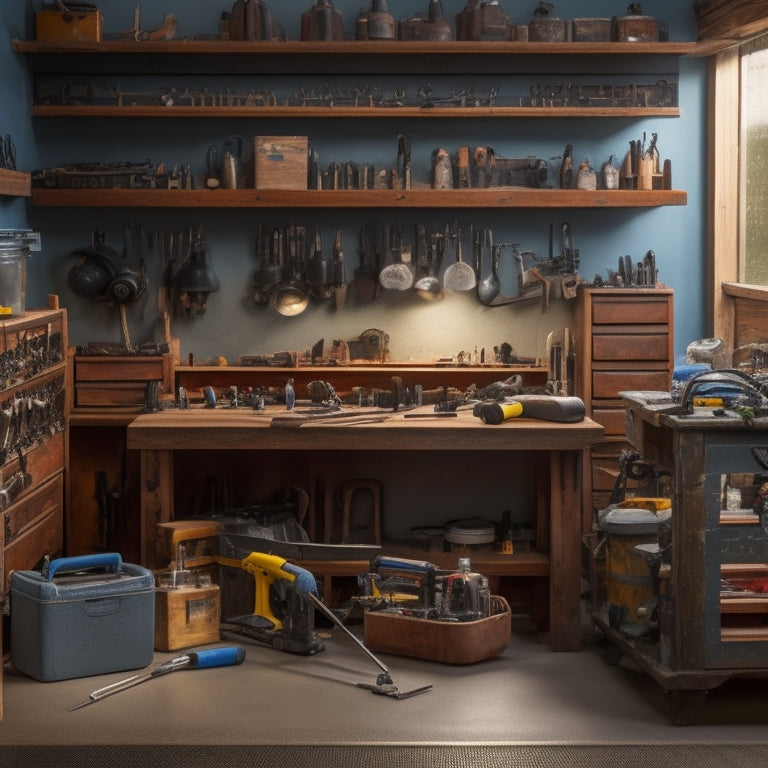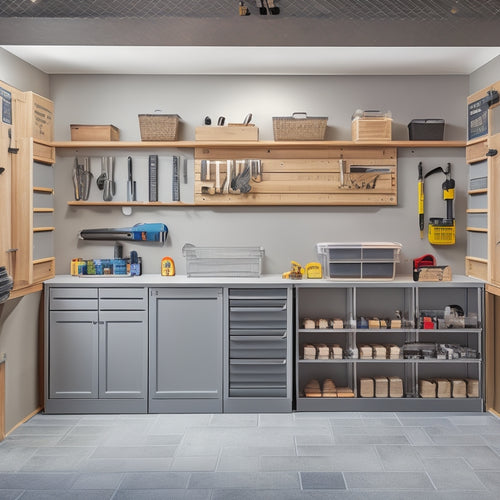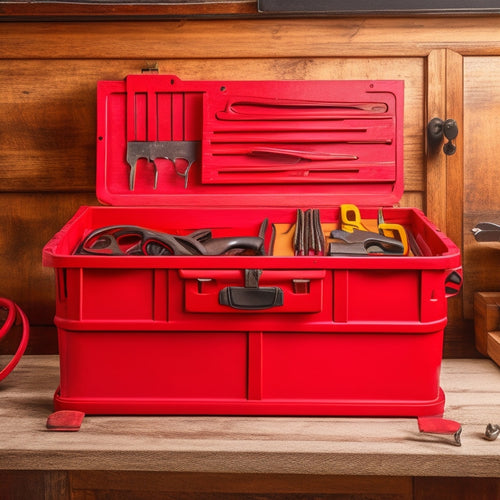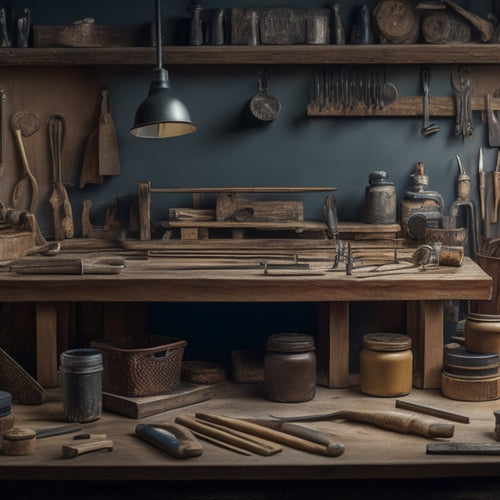
Smart Storage Solutions for Rotary Tool Organization
Share
You've got a stash of rotary tools, accessories, and attachments, and it's time to get them organized. Start by evaluating your collection, noting each item's condition, functionality, and frequency of use. Then, design a customized storage layout that utilizes vertical wall space and incorporates tailored compartments for each tool. Choose the right storage materials, like clear containers or pegboards, and maximize storage in small areas with compact shelves and tiered bins. Finally, implement clear labeling and signage to facilitate easy access. With a little planning and creativity, you'll be well on your way to a hassle-free workspace that's optimized for efficiency.
Key Takeaways
• Assess tools, accessories, and attachments to prioritize storage based on frequency of use and condition.
• Design a customized storage layout that utilizes vertical wall space and tailors compartments to fit tools snugly.
• Choose storage materials that optimize shelving, corner spaces, and small parts storage with proper labeling.
• Maximize storage efficiency in small areas with compact shelves, tiered bins, and specialized shelving.
• Establish clear signage standards and color coding for easy identification and accessibility of tools and accessories.
Assessing Your Rotary Tool Collection
Take inventory of your rotary tool collection by gathering all your tools, accessories, and attachments from their various storage locations, and spread them out in a well-lit, open area. This is the first step in evaluating your collection, and it's crucial to get a clear picture of what you're working with. As you lay out your tools, take note of each item's condition, functionality, and frequency of use. This will help you create a mental (or written) profile of each tool, which we'll refer to as Tool Profiling.
Next, prioritize your collection by identifying the most essential tools, the ones you use daily or weekly. These tools deserve prime storage real estate, making them easily accessible when you need them. Less frequently used tools can be stored in secondary locations, but still within easy reach. Collection Prioritization is key to an efficient storage system, ensuring that your most valuable tools are protected and easily accessible.
Designing a Custom Storage System
When designing a custom storage system for your rotary tools, you'll want to start by creating a customized storage layout that takes into account the unique shape and size of each tool. This will help you maximize your storage space and guarantee that every tool has a designated spot.
Customized Storage Layout
You create a personalized storage layout by first evaluating your available space and identifying the specific storage needs of your rotary tool collection. This involves taking stock of the types and quantities of tools you have, as well as their sizes and frequencies of use. By doing so, you can design a customized layout that maximizes your storage capacity and streamlines your workflow.
A well-planned layout should prioritize ergonomics, ensuring that your most frequently used tools are easily accessible and at a comfortable height. This will help you maintain an efficient workflow, reducing fatigue and increasing productivity.
Consider the 'golden zone' concept, where you position your tools within a 30-degree radius of your working area, minimizing the need for excessive bending or stretching.
Tool-Specific Compartment Design
With your customized storage layout in place, designing tool-specific compartments becomes a matter of precision, as each compartment must be tailored to snugly fit its corresponding tool, guaranteeing a secure and organized storage system that protects your valuable rotary tools and accessories.
You'll want to create compartmentalized trays with fixed dividers to separate and categorize your tools. For instance, you can designate a tray for drill bits, another for sanding drums, and a separate one for polishing wheels. Within each tray, use fixed dividers to further segregate tools by size, type, or frequency of use. This will prevent tools from getting jumbled, scratched, or lost.
When designing compartments, consider the tool's shape, size, and any unique features. For example, a compartment for a rotary hammer might need a deeper and wider space to accommodate its bulkier design. By meticulously planning each compartment, you'll guarantee that every tool has its own snug, protected space, making it easy to access and store your rotary tools and accessories.
Utilizing Vertical Wall Space
Rotary tool enthusiasts can maximize their workshop's potential by transforming oft-wasted vertical wall space into a sleek, organized hub for their beloved accessories. By utilizing wall anchors, you can create a sturdy foundation for your storage system, ensuring that your tools and accessories are always within reach. This approach not only saves floor space but also keeps your workstation clutter-free, allowing you to focus on your projects without distractions.
Here's a sample layout to get you started:
| Accessory | Storage Solution | Benefits |
|---|---|---|
| Drill bits | Magnetic strip | Easy access, reduces clutter |
| Sanding drums | Adjustable hooks | Customizable, space-efficient |
| Rotary tool cases | Wall-mounted shelves | Protects tools, saves floor space |
With a little creativity, you can turn your workshop's walls into a functional storage space. By incorporating space savers like adjustable hooks and magnetic strips, you can create a customized system that meets your specific needs. By doing so, you'll be able to work more efficiently, reduce stress, and enjoy your hobby even more.
Choosing the Right Storage Materials
When selecting storage materials for your rotary tool organization, you'll want to take into account the specific needs of your tools and workspace.
You'll need to contemplate the types of containers that will best protect and categorize your tools, as well as the shelving and racking systems that will maximize your storage space.
Storage Container Options
You'll find that selecting the right storage materials for your rotary tool organization is essential, as it directly impacts the durability and accessibility of your storage solution. When it comes to storage container options, you have a range of choices that are essential for your specific needs.
Here are some popular storage container options worth exploring:
| Material | Benefits |
|---|---|
| Clear Containers | Allows for easy visibility of contents, making it simple to find what you need |
| Stackable Drawers | Maximizes vertical storage space, keeping your workshop organized and clutter-free |
| Plastic Bins | Affordable, lightweight, and easy to clean |
| Metal Containers | Durable, resistant to scratches and corrosion |
| Fabric Storage | Soft, flexible, and ideal for storing delicate or irregularly shaped tools |
When choosing a storage container, take into account the size, material, and features that best fit your rotary tool collection. Clear containers and stackable drawers are great options for keeping your tools visible and organized, while plastic bins and metal containers offer durability and ease of cleaning. Fabric storage is perfect for storing delicate or unique tools. By selecting the right storage container, you'll be able to find what you need quickly and easily, saving you time and increasing your productivity.
Shelving and Racking
With your storage containers in place, it's time to contemplate the shelving and racking systems that will hold them, as the appropriate storage materials can greatly impact the overall functionality of your rotary tool organization system. You want to guarantee that your shelves and racks are sturdy, adjustable, and easy to assemble.
When choosing the right storage materials, consider the following key factors:
-
Corner optimization: Look for shelving units that can fit snugly into corners, maximizing your available space and reducing clutter.
-
Modular flexibility: Opt for shelving systems that can be easily reconfigured as your storage needs change over time.
-
Durability: Select materials that can withstand the weight of your rotary tools and accessories, such as heavy-duty metal or industrial-grade plastic.
- Customizability: Consider shelving units with adjustable shelves and compartments to accommodate tools of varying sizes and shapes.
Adhesive Backed Strips
By incorporating adhesive backed strips into your storage system, you can securely fasten small rotary tool accessories, such as drill bits and sanding drums, to the shelves or walls of your workstation, keeping them organized and within easy reach.
When it comes to strip placement, consider the frequency of use and the accessibility you need. Place strips in areas that allow you to quickly grab the accessories you need, reducing clutter and increasing productivity.
It's crucial to choose strips with high durability to guarantee they can hold the weight of your tools and withstand the wear and tear of daily use. Look for strips made from heavy-duty materials, such as industrial-grade adhesives and reinforced fabrics. These will provide a strong bond between the strip and the surface, keeping your tools securely in place.
When applying the strips, make sure the surface is clean and dry to establish a strong bond. Follow the manufacturer's instructions for application and weight limits to confirm the strips can handle the weight of your tools.
With the right adhesive backed strips, you can create a customized storage system that keeps your rotary tool accessories organized, accessible, and ready for use.
Creating a Pegboard Layout
Designate a specific area for your pegboard by measuring the available wall space and deciding on a layout that accommodates all your rotary tool accessories. This will guarantee a clutter-free workspace and maximize storage efficiency.
When planning your pegboard layout, consider the following essential aspects:
-
Pegboard orientation: Decide on a horizontal or vertical orientation based on the available wall space and your personal preference.
-
Board segmentation: Divide your pegboard into sections or zones to categorize your accessories, such as drill bits, sanding discs, and cutting wheels.
-
Accessory grouping: Group similar accessories together to enhance accessibility and reduce searching time.
- Tool frequency: Place frequently used tools in easy-to-reach areas, while less frequently used tools can be stored towards the bottom or top of the board.
Incorporating Small Parts Storage
You'll need to allocate space for small parts storage to keep your rotary tool accessories organized and prevent loss or misplacement of tiny components.
A well-designed small parts storage system will guarantee that you can quickly find the bits, burs, and other small accessories you need. Consider investing in a Micro Bin, a compact storage container with multiple compartments that can be attached to your pegboard or stored on a shelf. Each compartment can be labeled, making it easy to identify what's inside.
Another option is a Component Caddy, a small tray with separate slots for storing tiny parts. This is perfect for keeping track of small items like screws, nuts, or bolts.
When choosing a small parts storage solution, think about the types of accessories you use most frequently and how you can best organize them. By allocating space for small parts storage, you'll be able to work more efficiently and reduce frustration caused by lost or misplaced components.
Maximizing Storage in Small Areas
In cramped workshops or compact studios, every inch counts, and maximizing storage in small areas becomes essential to maintaining a clutter-free and organized space for your rotary tool collection. You can't afford to waste a single inch, and that's where clever storage solutions come in.
To make the most of your compact space, consider the following strategies:
-
Install Compact Shelves: Opt for wall-mounted shelves that can hold your rotary tools, accessories, and consumables, keeping them within easy reach while keeping the floor clear.
-
Optimize Corner Space: Utilize corner spaces with specialized shelving or carousels that can rotate to bring items to the front, making the most of this often-wasted area.
-
Use Vertical Storage: Maximize your ceiling height by installing tall storage units or pegboards that can hold tools, bits, and other equipment, keeping them organized and out of the way.
- Employ Tiered Storage: Incorporate multi-tiered storage bins or drawers that can hold small parts, consumables, and accessories, keeping them organized and easily accessible.
Labeling and Signage for Easy Access
Effective labeling and signage play a crucial role in maintaining easy access to your rotary tool collection, allowing you to quickly identify and retrieve the tools and accessories you need. When it comes to labeling, you'll want to establish clear signage standards that make sense for your specific storage setup.
Consider using color coding to categorize your tools and accessories by type, function, or frequency of use. This visual system will help you quickly scan your storage area and locate the item you need.
In addition to color coding, use clear and concise labels that identify the contents of each storage bin or compartment. You can also use labels to indicate the specific tool or accessory stored within, making it easy to grab what you need without having to dig through multiple containers.
Frequently Asked Questions
Can I Repurpose an Old Furniture Piece for Rotary Tool Storage?
"You're a master treasure hunter, repurposing an old furniture piece like a vintage treasure chest. Yes, you can breathe new life into upcycled drawers or vintage shelves, transforming them into a customized haven for your rotary tools."
How Do I Prevent Rust and Corrosion in My Storage System?
You'll want to prioritize moisture control and climate management to prevent rust and corrosion in your storage system - guarantee good airflow, monitor humidity levels, and use rust-inhibiting coatings or liners to safeguard your tools.
Are There Any Specific Safety Considerations for Storing Rotary Tools?
'Are you aware of the dangers lurking in your workshop? When storing rotary tools, you're not just safeguarding your investment, you're guaranteeing your safety. Secure easy tool access, and watch out for electrical hazards like frayed cords or exposed wiring.'
Can I Use a Modular Storage System for Easy Rearrangement?
You'll love the flexibility of a modular storage system, allowing you to easily rearrange customizable compartments and adjustable shelving to fit your unique needs, ensuring a tailored organization that adapts to your workflow.
Are There Any Specific Storage Solutions for Cordless Rotary Tools?
You'll love that there are specific storage solutions designed just for cordless rotary tools! Look for tool holders with individual compartments and battery trays that keep your tools and batteries organized, protected, and easily accessible.
Related Posts
-

Essential Steps for Garage Storage System Design
You're about to change your cluttered garage into an organized haven by following a structured approach to garage sto...
-

Portable Tool Chest Essentials
When stocking your portable tool chest, you'll want to prioritize essential hand tools like hammers, tape measures, a...
-

Top 5 Small Tool Organizers for Your Workshop
You're looking to optimize your workshop's efficiency with high-quality small tool organizers. Compact storage soluti...


